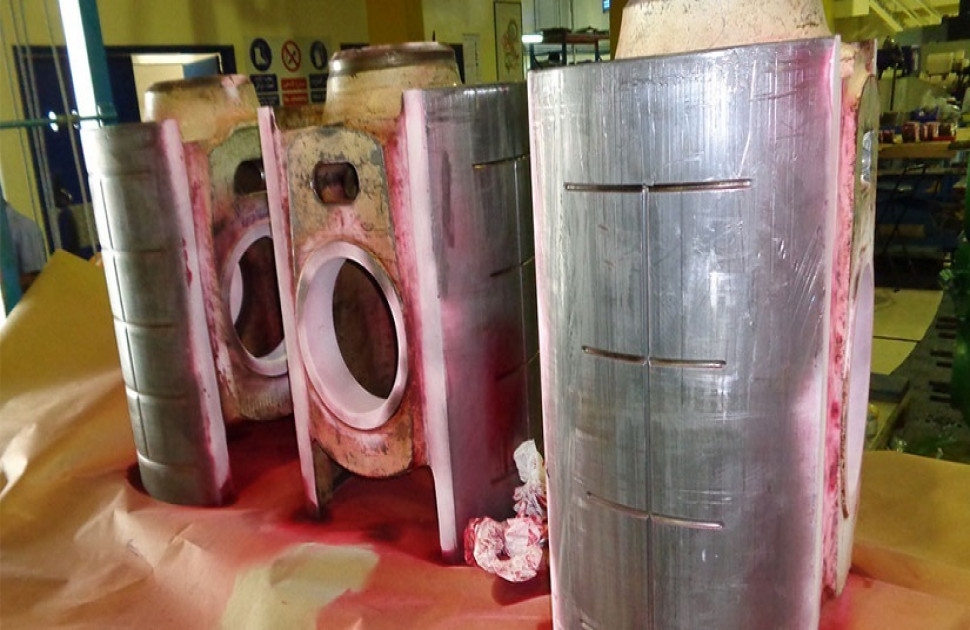Table of Content
- How do Developers Work?
- Types of Developers
How do Developers Work?
Developers enhance the visibility of penetrant indications by pulling the penetrant from a surface open discontinuity and spreading the penetrant through the developer coating on the part surface. The penetrant indication may appear larger than its actual size as the penetrant spreads through the developer over time. Specifications state minimum and maximum development times to address the spread of penetrant through the developer. The minimum development time should allow enough time for the penetrant to be pulled from the surface open flaw and spread on the part surface for enhanced visibility. The maximum development time is in place to minimize excessive penetrant “bleed out” from an indication that could potentially obscure the indication.
Developers also increase the contrast between the penetrant and part background. With fluorescent penetrant inspection, the developer coating decreases glare from shiny part surfaces when viewed under UV light, highlighting penetrant indications and reducing eye fatigue of inspectors. With visible penetrants, developers provide a white background so that red dye penetrant indications are easy to identify.
Developers are available in various forms. Always review applicable specifications and company test procedures to identify approved developer options.
Types of Developers
1. Dry Powder Developers
Dry powder developers are fluffy white powders that may be applied manually with powder spray bulbs or spray guns or by dipping and dragging parts in the dry powder developer. In automated penetrant systems, dry powder developers are applied in swirl cloud or dynamic cloud chambers.
Dry powder developers deposit a light dusting on the part surface and are only suitable for Type 1 fluorescent penetrant inspections. Specifications prohibit the use of dry powder developers with Type 2 visible dye penetrant inspections since dry powder developers would not provide an adequate white contrasting background for visible dye penetrants.
2. Water Soluble Developers
Water soluble developers are supplied in powder form and are mixed with water according to the manufacturer’s directions. The supplied powder will dissolve in water and only requires agitation during the solution preparation. Water soluble developers are only for use with fluorescent penetrants. Water-soluble developers may not be used with Type 2 visible dye penetrants because, like dry powder developers, water-soluble developers do not produce an adequate white contrasting background that is necessary for visible dye penetrant inspection.
3. Water Suspendable Developers
Like water soluble developers, water suspendible developers are supplied in powder form and mixed with water according to the manufacturer’s instructions. However, water-suspendable developers do not dissolve in water. Instead, they form a developer suspension. The developer suspension must be continuously agitated to provide a consistent developer concentration. Water-suspendable developers may be used with both Type 1 fluorescent and Type 2 visible dye penetrants since water-suspendable developers produce a suitable white developer coating that enhances both visible dye and fluorescent penetrant indications.
4. Nonaqueous Developers
Nonaqueous developers are supplied and ready to use. Spray is the preferred application method for nonaqueous developers, and aerosol cans are a convenient option. Nonaqueous developers contain white powders suspended in volatile solvents and require mixing prior to use. When applied by spray, the solvent evaporates and leaves a dry white developer coating on the part surface. Nonaqueous developers are suitable for both Type 1 fluorescent and Type 2 visible dye penetrant inspections.
Parts must be completely dry before application of dry powder and nonaqueous developers. Water soluble and water suspendable developers are applied to wet parts after the penetrant rinse removal step. Parts are typically dried in a hot air dryer after application of water-soluble or water-suspendible developer.
5. Non-Aqueous Wet Developer Aerosols
Non-aqueous wet developer aerosols are powder particles mixed with a quick-drying solvent. The powder is suspended in the solvent and is sprayed onto a substrate. The solvent evaporates, leaving an opaque white coating and contrasting background for fluorescent and visible penetrant inspections. The product is available in an aerosol can for quick and easy inspection in the field. Aerosol kits are available that include cleaners, developers, and penetrants so each step in the process is on hand when you need it.
References:
1. Magnaflux









